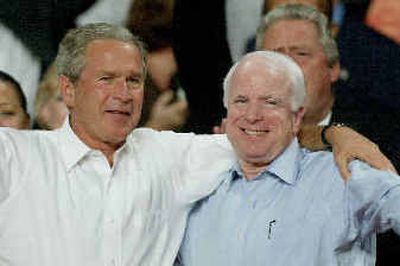Politicians’ hugs send a message

It begins with a handshake. Then a left hand goes to a shoulder. Then a standard manly greeting evolves into something else entirely: a full-body, lingering political hug.
President Bush and Sen. John McCain, onetime political enemies, demonstrated the technique at campaign rallies across the country this week. The gesture was meant to convey their newfound solidarity and probably did so more emphatically than the effusive praise they heaped on each other. In Pensacola, Fla., Bush even planted a smooch on McCain’s temple.
After Sen. John Kerry named Sen. John Edwards his running mate, their endless energetic hugs were interpreted as a sign of heartfelt partnership. They leapt into each other’s arms so regularly that Jay Leno produced a video montage of their embraces set to Joe Cocker’s song “You Are So Beautiful.”
This year’s presidential tickets are demonstrating the classic double-politician hug. “In some cases it reflects the genuine emotion of the moment,” says Bill Dal Col, a Republican strategist who managed Steve Forbes’ 2000 presidential campaign. “In every case it’s to send a message.” Other varieties:
The regular-guy friendly hug
This variation is employed to disarm and charm. Local volunteers always greet Bush at airports where Air Force One lands. Last month in Grand Rapids, Mich., the civilian was Cal Steele, who handed Bush a small box of cherries. He was rewarded with an encompassing hug that made Steele a local celebrity. At a school in Las Vegas on Tuesday, Kerry gave a big, photogenic hug to a woman who said she had switched her party registration from Republican to Democrat.
The empathetic hug
Consoling people after tragedy is an important presidential duty. At a memorial service after the Oklahoma City bombing in 1995, President Clinton’s sympathetic hugs were credited with soothing fears and embodying the nation’s grief. Empathy became a hallmark of his presidency. In Bush’s 2002 State of the Union address, he talked of hugging people shattered by Sept. 11.
“As I have met the heroes, hugged the families, and looked into the tired faces of rescuers, I have stood in awe of the American people,” he said.
The anoint-and-elevate hug
Clinton hugged Russian President Boris Yeltsin every time they were in the same room. The message: This is an important man I trust and can work with. In September 1998, at the height of the Monica Lewinsky scandal, South African leader Nelson Mandela said during a visit to the White House that he was thinking of Clinton “at this difficult and distressing time.” Their hug suggested that if Mandela, a human-rights hero, could forgive Clinton, so should everybody else.
The spontaneous hug
After addressing Congress in the wake of the Sept. 11 attacks, Bush shared an impulsive hug with Democratic Senate leader Tom Daschle. The clinch hinted at bipartisanship – which soon evaporated. Entertainer Sammy Davis Jr. hugged President Nixon in 1972 and was teased about it for the rest of his life.
The phantom hug
In June, Daschle learned about the hazards of the hug. He was criticized at home in South Dakota after being wrongly accused of hugging filmmaker Michael Moore at a showing of the Bush-bashing movie “Fahrenheit 9/11.”
Political hugging doesn’t come naturally to every politician. Vice President Cheney has never been seen in public throwing his arms around Bush. In Bob Woodward’s book about the Iraq war, “Plan of Attack,” Woodward documents a rare Cheney hug.
After former Reagan administration official Kenneth Adelman wrote an op-ed piece praising the administration for what appeared then to be a quick victory in Iraq, Cheney invited him to dinner. “Adelman was so happy that he burst into tears at the door of the vice president’s residence that Sunday,” Woodward wrote. “He hugged Cheney for the first time in the 30 years he had known him.”
Some political analysts say hugging is a calculated attempt to appeal to women, who are more apt than men to respond favorably to a candidate’s show of emotion. Stephen Hess, a presidential scholar at the Brookings Institution, a Washington think tank, says politicians are reflecting shifts in the culture.
“It’s an outward show of affection,” he said. “That’s pretty healthy. And of course the politicians just mirror where society is at any time. Can you imagine Abe Lincoln in his stovepipe hat hugging Stephen Douglas? This reflects the times in an interesting way.”
But Democratic strategist Paul Begala finds all the cuddling distasteful. “FDR didn’t hug Harry Truman, and it’s hard to imagine George Washington blowing kisses to John Adams,” he said. “I don’t know if we need to go all the way back to the days when Congressman Preston Brooks nearly beat Senator Charles Sumner to death on the Senate floor with his cane” – that was 1856 – “but do we really need Dr. Phil on the ticket?”
Dal Col warns that ancient Roman history shows that hugs are not a new political tool – nor are they always as chummy as they seem.
“Julius Caesar got hugged by Brutus,” he says, “but on that last hug we know what happened.”